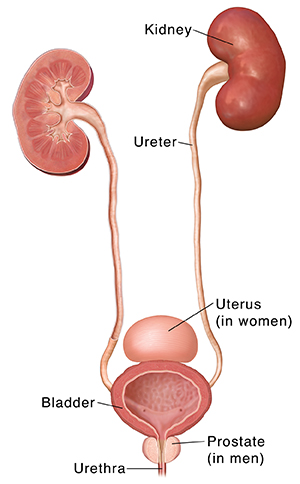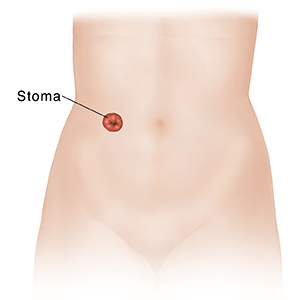What Is a Urostomy?
What Is a Urostomy?
Urostomy is surgery that provides a new way for the body to get rid of urine (waste fluid). It is done when the bladder is diseased or damaged. During the surgery, the surgeon brings part of the urinary tract or some of the digestive tract through the abdominal wall. Urostomy can be done in any of the ways described below. In each case, a small opening (stoma) is made on the abdomen (belly). This allows urine and mucus to pass out of the body.
The urinary tract
This organ system rids the body of urine and is made up of many parts. They include 2 kidneys, 2 ureters, the bladder, and the urethra. The kidneys remove unneeded substances and extra water from the blood. This makes urine. The ureters transport urine from the kidneys to the bladder. The bladder stores urine. The urethra releases urine from the bladder to outside the body.
Common types of urostomies
These include:
Ileal conduit. This surgery makes a passage (conduit) from part of the ileum. This is the last section of the small intestine. Urine leaves the body through this passage. One end of the conduit is sewn shut. The other end is brought through the abdominal wall to form a stoma. The ureters are detached from the bladder and connected to the conduit. Urine flows through the ureters and into the conduit. Urine then leaves the body through the stoma. This surgery does not change the way stool passes from the body. An ileal conduit is the most common type of urostomy.
Colon conduit. This surgery is done much like an ileal conduit. But with a colon conduit the passage is made from a piece of the colon and not the ileum. The resulting stoma is bigger, as the colon is wider than the ileum.
Ureterostomy. This surgery brings the ureters through the abdominal wall to form one or two stomas. In this case, the stoma or stomas are smaller. This is because the ureters are more slender than the ileum or the colon.
Continent cutaneous diversion. A pouch may be created under the skin of the abdomen using tissue from the stomach or intestines. The urine is collected in the pouch and is kept from leaving because of a valve. The patient does not wear a bag. Instead, a thin tube called a catheter is used to occasionally empty the pouch.
Orthotopic neobladder. This is commonly known as a neobladder because, in some people, it may be possible to create a new bladder from a section of bowel. Because the new bladder is connected to the urethra, a person can urinate normally. No stoma is needed since the urine empties naturally through the urethra. If the new bladder doesn’t function as a normal bladder, a catheter may have to be inserted to drain urine.
The stoma
The stoma is an opening on the abdomen through which urine and mucus can pass. It is made by bringing the end of the ileum, the colon, or one or both ureters through the abdominal wall. This end is then turned back on itself, like a cuff.
The stoma is pink or red and moist. This is because the insides of the ileum, the colon, and the ureters are like the inside of the mouth.
The stoma shrinks to its final size 6 to 8 weeks after surgery. Then it will be round or oval. The stoma will either be flat or it will sit ¼ to ½ inch above the skin.
With an ileal or a colon conduit, both urine and mucus pass through the stoma. After a ureterostomy, only urine comes out of the stoma.
Urine draining from the stoma is typically collected into an attachable pouch. Urine can be drained from the pouch at your convenience or when the pouch is full.
Updated:
March 21, 2017
Sources:
Urinary Diversion. The National Institute of Diabetes and Digestive and Kidney Diseases National Institutes of Health
Reviewed By:
Brown, Kim, APRN,Greenstein, Marc, DO

